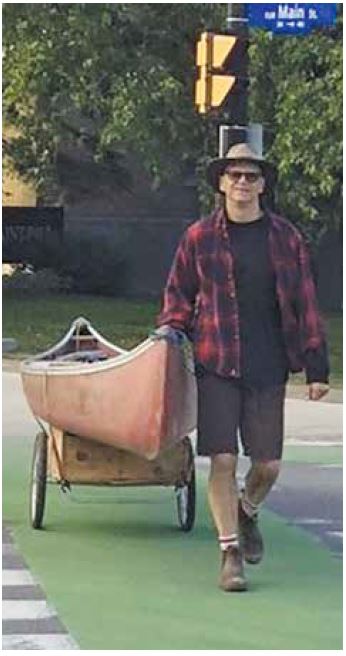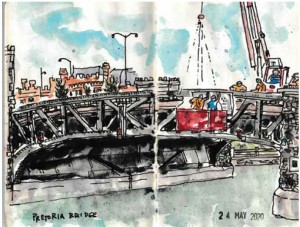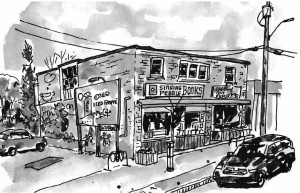Tanis Browning Shelp
When visual artist Tim Hunt found himself off work during the first few months of the pandemic, he was inspired by Urban Sketchers from across the globe to get out and sketch our city life, capturing it “warts and all.” Hunt and his wife Karen Massey both pursue an art form. Massey is an award-winning poet. “We work to pay the rent, so the time for doing our art isn’t always there,” Hunt explains. “The temporary shutdown of my workplace this past spring gave me a turn.”

Old Ottawa East urban sketcher Tim Hunt seen here crossing Main Street recently with his canoe in tow. Photo Supplied
For many years, Hunt focused on collage and sculpture using found objects and “all manner of rusty, broken, and discarded things,” he says. Viewing the work of Urban Sketchers on Instagram in March took him back to the simplicity of drawing. “I have lots of metal objects and other items kicking around for making my art installations,” Hunt says. “In the quiet and meditative days in isolation with my family (Massey and Hunt have two teenagers), I found myself reevaluating the idea of keeping all of this stuff. I made a personal pact to embrace my first love of drawing and sketching.”
Hunt compares urban sketching to living the artist’s dream. “You walk out the door with a small sketchbook, pen, and watercolour kit,” he says. Urban Sketchers is a global community of artists with chapters in cities all over the globe. Hunt began walking, cycling, and sketching all over Ottawa, sometimes for three or four hours a day. For the past 10 years, he has been working night shifts. “I’m a morning person, so it’s been refreshing to be back outside in the daylight.” Soon, he began posting his own urban sketches on Instagram.
“I do my drawings in pen and if time, space, and weather permit I also paint/colour them on location, which is the Urban Sketchers way,” Hunt says. “But I confess that sometimes, on cold days, I might do the drawing on-site and finish the painting at home.” On average, the sketches take about an hour and a quarter to complete. But when the weather is pleasant, Hunt spends more time on them. “I’m less comfortable drawing where people can watch me,” he admits. “So, a pandemic is a good time for me to do this work because people are unlikely to approach me. I usually park myself in a corner where I won’t be in somebody’s path.”
Urban Sketchers often draw people while sitting in cafés or libraries. “But these places were closed, so I had to go to where the people were,” Hunt says. “Artists in different parts of the world were capturing the Black Lives Matter rallies, so I tried to do the same. It was powerful to be out during the event and feel the energy. But you had to draw quickly. The people, of course, we’re moving, so to complete a drawing you had to be moving too! I got jostled around, so it was challenging just to put something on the page. I think the drawings give viewers the feeling of being there.”
Hunt’s drawing of Singing Pebble Books (see below) marked a pandemic-style departure from the norm in urban sketching. “When many cities around the world were in lockdown, the Urban Sketchers organization would assign drawings of ordinary items that you’d find inside your home,” Hunt explains. They also assigned drawings of places out in the community, such as a local bookstore, and recommended using Google Street View to inform your work. “I used a Google Street View image of Singing Pebble Books for my own sketch,” Hunt explains, “but since I walk past the store so often I felt like I was drawing it from my own experiences being out in the community.”
Hunt has focused on themes of demolition, destruction, and development in his work for years. In 2017, when Old Ottawa East was transforming Main Street into a complete street and the Greystone project was in its early stages, the community’s loss of several mature trees inspired Hunt and two other artists, Annette Hegel and Karin Bell, to create an art project. “The trees that were destined to be cut down were marked with an X,” Hunt says. “We gave them Hello, My Name Is name tags and named each tree as a way of honouring it before it was cut down. We even freed a few of them—still wearing their name tags—from the woodchipper. We used those trees for a project called May Day in which we photographed each tree before and after the trees were cut down. The bike paths on the complete street were great, but I had mixed feelings because it was sad to see the trees go.”
Hunt is currently interested in sketching buildings that are destined for demolition. He recently focused on some houses on Robinson Avenue, a short street that sits near the Queensway between Sandy Hill and Old Ottawa East. “When you look at the buildings on Robinson, you might think they’re run down or you might think they’re cool,” Hunt says. “But people had been living in them for 100 years and now this little community is coming down one house at a time. By sketching those buildings I’m capturing an area of the city as it is changing. I’m chronicling its history.”
Urban sketching is like reportage. “You draw something as you see it happening,” Hunt says. “In the summertime, I stationed myself in a bush on a hill above the bike path to sketch some construction work being done on Pretoria Bridge. I was capturing something that was happening right then, a change in our community. There is a rawness and energy in that immediacy.”
![]() To see more of Tim Hunt’s urban sketches, his Instagram coordinates are @timhuntottawa. You can view the work of Ottawa Urban Sketchers at the Urban Sketchers Ottawa Facebook Group.
To see more of Tim Hunt’s urban sketches, his Instagram coordinates are @timhuntottawa. You can view the work of Ottawa Urban Sketchers at the Urban Sketchers Ottawa Facebook Group.
Author Tanis Browning-Shelp (http://www.browning-shelp.com) pens her Maryn O’Brien Young Adult Fiction series, published by Dog-Eared Books, from her home in Old Ottawa East.
Contact tanis@browning-shelp.com if you have information about artists or art events that you believe would enrich our community members’ lives.








